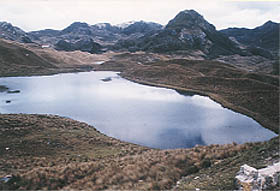Area Nacional de Recreación Cajas
 |
This 28,800-hectare recreation area lies about 30 km west of Cuenca and is famous for its many beautiful lakes - well over 200 have been named, and there are countless smaller ponds, pools and puddles. There are trout in the lakes and fishing is permitted. The terrain is bleak and rough and the lakes shine like jewels against the harsh country side. It is rugged hiking and camping country, much of it páramo at 4000 meters above sea level. None of the area is above 4500 meter, so it doesn't normally snow, although the winds and rains can make it very cold. Hikers and campers should be well prepared with warm, windproof gear and plenty of energy. Several readers have written to say that they underestimated the cold weather and had a very cold trip - bring protective clothing! Flora & Fauna In sheltered hollows and natural depressions in the terrain, small forests of the quinua (Polyepis) tree are seen. This tree grows at the highest altitudes of any tree in the world, and the quinua thickets provide welcome protection from the elements for all kinds of unusual plants and animals. Everything is on a small, tightly packed scale, and forcing your way into one of these dense dwarf forests is like entering a scene from a Grimm's fairy tale. Bird watchers will have a great time looking for the many different species of on the lakes, the quinua forests and in the surrounding páramo. These are the habitats of such evocatively named birds as the giant conebill, tit-like dacnis and grea breasted mountain toucan. A variety of exotically named humming birds can also be seen: the rainbow-bearded thornbill, saphire-vented puffleg and purple throated sunangel, just to name a few. Raptors, including on rare occasions the Andean Condor, lazily flap overhead. Even the LBBs (little brown birds) that hop unobtrusively through the thickets have interesting names like mouse-colored thistletail. Bring binoculars and a field guide if you have them. Taken from Lonely Planet book : "Ecuador and the Galapagos Island". |